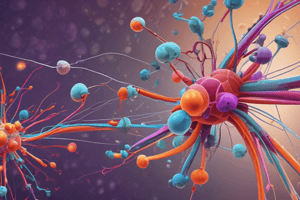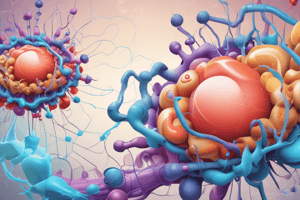Podcast
Questions and Answers
Which of the following is an example of a coenzyme?
Which of the following is an example of a coenzyme?
- Heme
- NADH (correct)
- Metal ions
- Biotin
Which of the following is a characteristic of a prosthetic group?
Which of the following is a characteristic of a prosthetic group?
- It can shuttle between enzymes
- It is an inorganic molecule
- It is an integral part of the enzyme's structure (correct)
- It is loosely bound to the enzyme
Which of the following statements about cofactors is true?
Which of the following statements about cofactors is true?
- Cofactors can be tightly or loosely bound to the enzyme (correct)
- Cofactors are non-essential for enzyme activity
- Cofactors are always organic molecules
- Cofactors are only inorganic molecules
Which of the following is a characteristic of a coenzyme?
Which of the following is a characteristic of a coenzyme?
Which of the following is a characteristic of a cofactor?
Which of the following is a characteristic of a cofactor?
Which of the following is a characteristic of a prosthetic group?
Which of the following is a characteristic of a prosthetic group?
Which of the following is an example of a coenzyme?
Which of the following is an example of a coenzyme?
Which of the following is an example of a cofactor?
Which of the following is an example of a cofactor?
Which of the following is an example of a prosthetic group?
Which of the following is an example of a prosthetic group?
Which of the following is true about coenzymes?
Which of the following is true about coenzymes?
Which of the following is true about cofactors?
Which of the following is true about cofactors?
Which of the following is true about prosthetic groups?
Which of the following is true about prosthetic groups?
Which of the following is true about apoenzyme and coenzyme?
Which of the following is true about apoenzyme and coenzyme?
Which of the following is a characteristic of a coenzyme?
Which of the following is a characteristic of a coenzyme?
Which of the following is an example of a prosthetic group?
Which of the following is an example of a prosthetic group?
Which of the following is true about cofactors?
Which of the following is true about cofactors?
Which of the following is true about prosthetic groups?
Which of the following is true about prosthetic groups?
Which of the following is an example of a coenzyme?
Which of the following is an example of a coenzyme?
Which of the following is a characteristic of a cofactor?
Which of the following is a characteristic of a cofactor?
Which of the following is true about coenzymes?
Which of the following is true about coenzymes?
Which of the following is true about apoenzyme and coenzyme?
Which of the following is true about apoenzyme and coenzyme?
Which of the following is a characteristic of a prosthetic group?
Which of the following is a characteristic of a prosthetic group?
Which of the following is an example of a cofactor?
Which of the following is an example of a cofactor?
Flashcards are hidden until you start studying
Study Notes
Cofactors and Coenzymes
- Coenzymes: non-protein molecules that bind to enzymes, assisting in catalysis, and are often derivatives of vitamins
- Cofactors: ions or molecules that bind to enzymes, enabling catalysis, and can be metal ions, vitamins, or derived from vitamins
- Prosthetic groups: tightly bound molecules, often covalently attached, that are integral to the enzyme's active site and involved in catalysis
Characteristics of Coenzymes
- Loose binding to the enzyme, allowing for easy removal and reattachment
- Can be used multiple times, recycled, or re-synthesized
- Often involved in group transfer reactions, redox reactions, or acid-base catalysis
Characteristics of Cofactors
- Can be inorganic ions, such as metal ions (e.g., Fe, Zn, Cu), or organic molecules (e.g., vitamins, flavins)
- Bind to the enzyme, often with varying degrees of strength, to facilitate catalysis
- Can be tightly bound (prosthetic group) or loosely bound (coenzyme-like)
Characteristics of Prosthetic Groups
- Tightly bound to the enzyme, often covalently attached
- Integral to the enzyme's active site, involved in catalysis
- Examples include flavin adenine dinucleotide (FAD) and heme groups
True Statements about Coenzymes, Cofactors, and Prosthetic Groups
- Apoenzyme (enzyme without cofactor) + coenzyme = active enzyme
- Coenzymes can be removed and reattached to the enzyme
- Cofactors can be metal ions, vitamins, or derived from vitamins
- Prosthetic groups are tightly bound to the enzyme and involved in catalysis
Studying That Suits You
Use AI to generate personalized quizzes and flashcards to suit your learning preferences.




